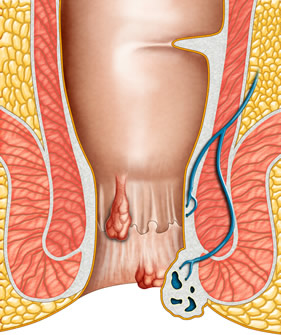
 Hemorrhoids (HEM-uh-roids), also called piles, are swollen and inflamed veins in your anus and lower rectum. Hemorrhoids may result from straining during bowel movements or from the increased pressure on these veins during pregnancy, among other causes. Hemorrhoids may be located inside the rectum (internal hemorrhoids), or they may develop under the skin around the anus (external hemorrhoids).
Hemorrhoids (HEM-uh-roids), also called piles, are swollen and inflamed veins in your anus and lower rectum. Hemorrhoids may result from straining during bowel movements or from the increased pressure on these veins during pregnancy, among other causes. Hemorrhoids may be located inside the rectum (internal hemorrhoids), or they may develop under the skin around the anus (external hemorrhoids).
Hemorrhoids are common ailments. By age 50, about half of adults have had to deal with the itching, discomfort and bleeding that can signal the presence of hemorrhoids.
Fortunately, many effective options are available to treat hemorrhoids. Most people can get relief from symptoms by using home treatments and making lifestyle changes.
Signs and symptoms of hemorrhoids may include
Hemorrhoid symptoms usually depend on the location. Internal hemorrhoids lie inside the rectum. You usually can't see or feel these hemorrhoids, and they usually don't cause discomfort.
But straining or irritation when passing stool can damage a hemorrhoid's delicate surface and cause it to bleed. Occasionally, straining can push an internal hemorrhoid through the anal opening. This is known as a protruding or prolapsed hemorrhoid and can cause pain and irritation.
External hemorrhoids are under the skin around your anus. When irritated, external hemorrhoids can itch or bleed. Sometimes blood may pool in an external hemorrhoid and form a clot (thrombus), resulting in severe pain, swelling and inflammation.
Bleeding during bowel movements is the most common sign of hemorrhoids. But rectal bleeding can occur with other diseases, including colorectal cancer and anal cancer. Don't assume that bleeding is coming from hemorrhoids without consulting a doctor.
Your doctor can do a physical examination and perform other tests to diagnose hemorrhoids and rule out more-serious conditions or diseases. Also consider seeking medical advice if your hemorrhoids cause pain, bleed frequently or excessively, or don't improve with home remedies.
If your hemorrhoid symptoms began along with a marked change in bowel habits or if you're passing black, tarry or maroon stools, blood clots, or blood mixed in with the stool, consult your doctor immediately. These types of stools can signal more extensive bleeding elsewhere in your digestive tract.
Seek emergency care if you experience large amounts of rectal bleeding, lightheadedness, dizziness or faintness.
The veins around your anus tend to stretch under pressure and may bulge or swell. Swollen veins (hemorrhoids) can develop from an increase in pressure in the lower rectum. Factors that might cause increased pressure include:
Hemorrhoids are more likely as you get older because the tissues that support the veins in your rectum and anus can weaken and stretch with aging.
Most of the time, treatment for hemorrhoids involves steps that you can take on your own, such as lifestyle modifications. But sometimes medications or surgical procedures are necessary.
If your hemorrhoids produce only mild discomfort, your doctor may suggest over-the-counter creams, ointments, suppositories or pads. These products contain ingredients, such as witch hazel or hydrocortisone, that can relieve pain and itching, at least temporarily.
Don't use an over-the-counter cream or other product for more than a week unless directed by your doctor. These products can cause side effects, such as skin rash, inflammation and skin thinning.
If a blood clot has formed within an external hemorrhoid, your doctor can remove the clot with a simple incision, which may provide prompt relief. For persistent bleeding or painful hemorrhoids, your doctor may recommend another minimally invasive procedure. These treatments can be done in your doctor's office or other outpatient setting.
Rubber band ligation - Your doctor places one or two tiny rubber bands around the base of an internal hemorrhoid to cut off its circulation. The hemorrhoid withers and falls off within a week. This procedure — called rubber band ligation — is effective for many people.
Hemorrhoid banding may cause bleeding, which might begin two to four days after the procedure but is rarely severe.
Injection (sclerotherapy) - in this procedure, your doctor injects a chemical solution into the hemorrhoid tissue to shrink it. While the injection causes little or no pain, it may be less effective than rubber band ligation.
Coagulation (infrared, laser or bipolar) - Coagulation techniques use laser or infrared light or heat. They cause small, bleeding, internal hemorrhoids to harden and shrivel.
While coagulation has few side effects, it's associated with a higher rate of hemorrhoids coming back (recurrence) than is the rubber band treatment.
If other procedures haven't been successful or you have large hemorrhoids, your doctor may recommend a surgical procedure. Surgery can be performed on an outpatient basis or you may need to stay in the hospital overnight.
Hemorrhoid removal - During a hemorrhoidectomy, your surgeon removes excessive tissue that causes bleeding. Various techniques may be used. The surgery may be done with a local anesthetic combined with sedation, a spinal anesthetic or a general anesthetic.
Hemorrhoidectomy is the most effective and complete way to treat severe or recurring hemorrhoids. Complications may include temporary difficulty emptying your bladder and urinary tract infections associated with this problem.
Most people experience some pain after the procedure. Medications can relieve your pain. Soaking in a warm bath also may help.
Hemorrhoid stapling - This procedure, called stapled hemorrhoidectomy or stapled hemorrhoidopexy, blocks blood flow to hemorrhoidal tissue. Stapling generally involves less pain than hemorrhoidectomy and allows an earlier return to regular activities.
Compared with hemorrhoidectomy, however, stapling has been associated with a greater risk of recurrence and rectal prolapse, in which part of the rectum protrudes from the anus. Talk with your doctor about what might be the best option for you.